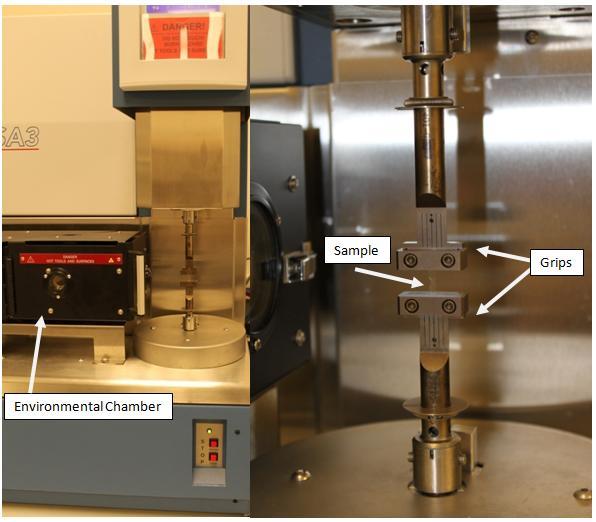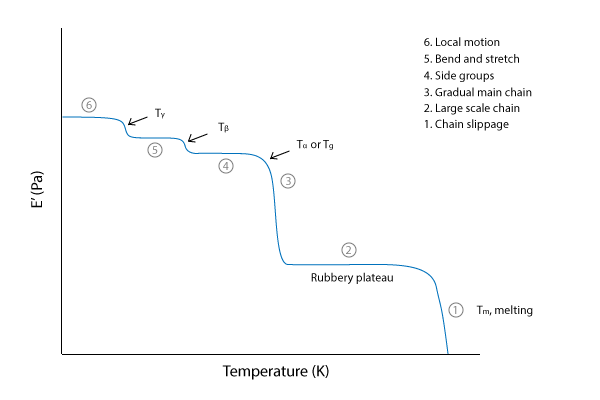| << Chapter < Page | Chapter >> Page > |

The DMA should be ideally selected to analyze the material at hand. The DMA can be either stress or strain controlled: strain-controlled analyzers move the probe a certain distance and measure the stress applied; strain-controlled analyzers provide a constant deformation of the sample ( Figure 4 ). Although the two techniques are nearly equivalent when the stress-strain plot ( Figure 1 ) is linear, stress-controlled analyzers provide more accurate results.

DMA analyzers can also apply stress or strain in two manners—axial and torsional deformation ( Figure 4 ). Axial deformation applies a linear force to the sample and is typically used for solid and semisolid materials to test flex, tensile strength, and compression. Torsional analyzers apply force in a twisting motion; this type of analysis is used for liquids and polymer melts but can also be applied to solids. Although both types of analyzers have wide analysis range and can be used for similar samples, the axial instrument should not be used for fluid samples with viscosities below 500 Pa-s, and torsional analyzers cannot handle materials with high modulus.
Different fixtures can be used to hold the samples in place and should be chosen according to the type of samples analyzed. The sample geometry affects both stress and strain and must be factored into the modulus calculations through a geometry factor. The fixture systems are specific to the type of stress application. Axial analyzers have a greater number of fixture options; one of the most commonly used fixtures is extension/tensile geometry used for thin films or fibers. In this method, the sample is held both vertically and lengthwise by top and bottom clamps, and stress is applied upwards ( Figure 5 ).

For torsional analyzers, the simplest geometry is the use of parallel plates. The plates are separated by a distance determined by the viscosity of the sample. Because the movement of the sample depends on its radius from the center of the plate, the stress applied is uneven; the measured strain is an average value.
As the temperature of a polymer increases, the material goes through a number of minor transitions ( T γ and T β ) due to expansion; at these transitions, the modulus also undergoes changes. The glass transition of polymers ( T g ) occurs with the abrupt change of physical properties within 140-160 o C; at some temperature within this range, the storage (elastic) modulus of the polymer drops dramatically. As the temperature rises above the glass transition point, the material loses its structure and becomes rubbery before finally melting. The idealized modulus transition is pictured in Figure 6 .

The glass transition temperature can be determined using either the storage modulus, complex modulus, or tan δ (vs temperature) depending on context and instrument; because these methods result in such a range of values ( Figure 7 ), the method of calculation should be noted. When using the storage modulus, the temperature at which E’ begins to decline is used as the T g . Tan δ and loss modulus E” show peaks at the glass transition; either onset or peak values can be used in determining T g . These different methods of measurement are depicted graphically in Figure 7 .
Dynamic mechanical analysis is an essential analytical technique for determining the viscoelastic properties of polymers. Unlike many comparable methods, DMA can provide information on major and minor transitions of materials; it is also more sensitive to changes after the glass transition temperature of polymers. Due to its use of oscillating stress, this method is able to quickly scan and calculate the modulus for a range of temperatures. As a result, it is the only technique that can determine the basic structure of a polymer system while providing data on the modulus as a function of temperature. Finally, the environment of DMA tests can be controlled to mimic real-world operating conditions, so this analytical method is able to accurately predict the performance of materials in use.
DMA does possess limitations that lead to calculation inaccuracies. The modulus value is very dependent on sample dimensions, which means large inaccuracies are introduced if dimensional measurements of samples are slightly inaccurate. Additionally, overcoming the inertia of the instrument used to apply oscillating stress converts mechanical energy to heat and changes the temperature of the sample. Since maintaining exact temperatures is important in temperature scans, this also introduces inaccuracies. Because data processing of DMA is largely automated, the final source of measurement uncertainty comes from computer error.

Notification Switch
Would you like to follow the 'Physical methods in chemistry and nano science' conversation and receive update notifications?